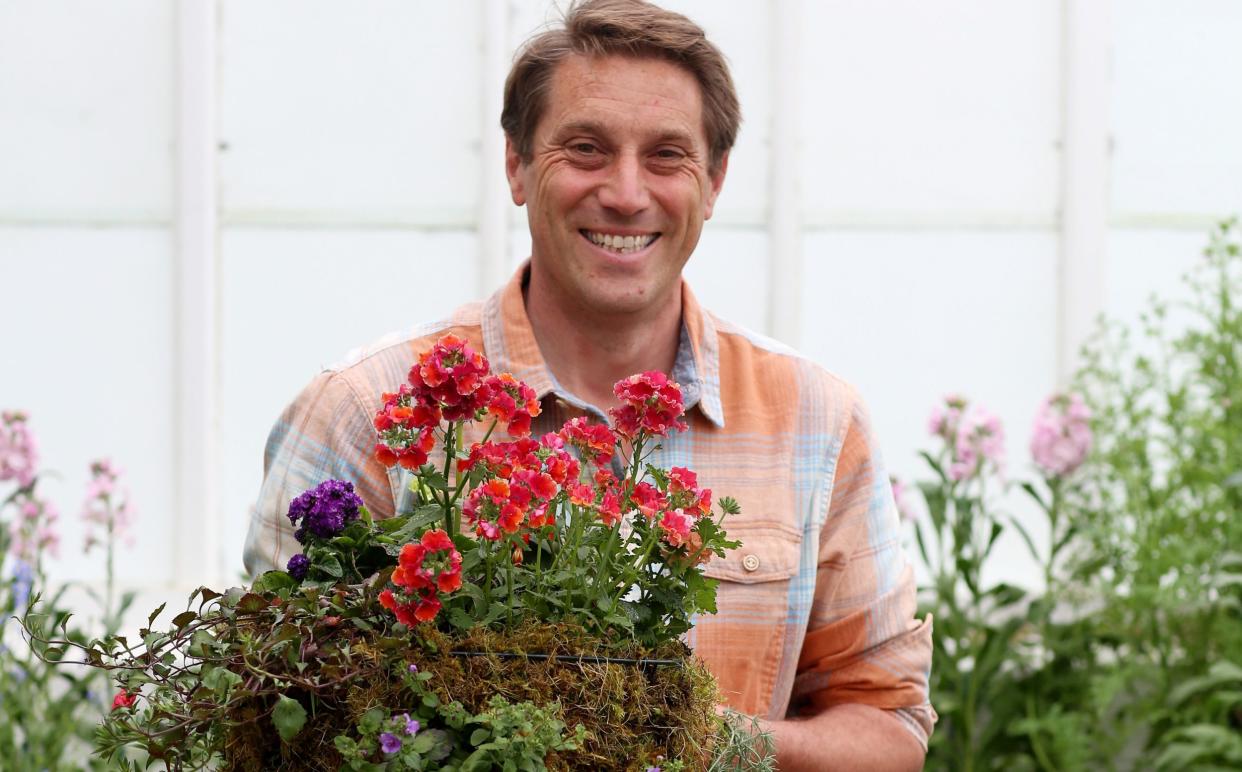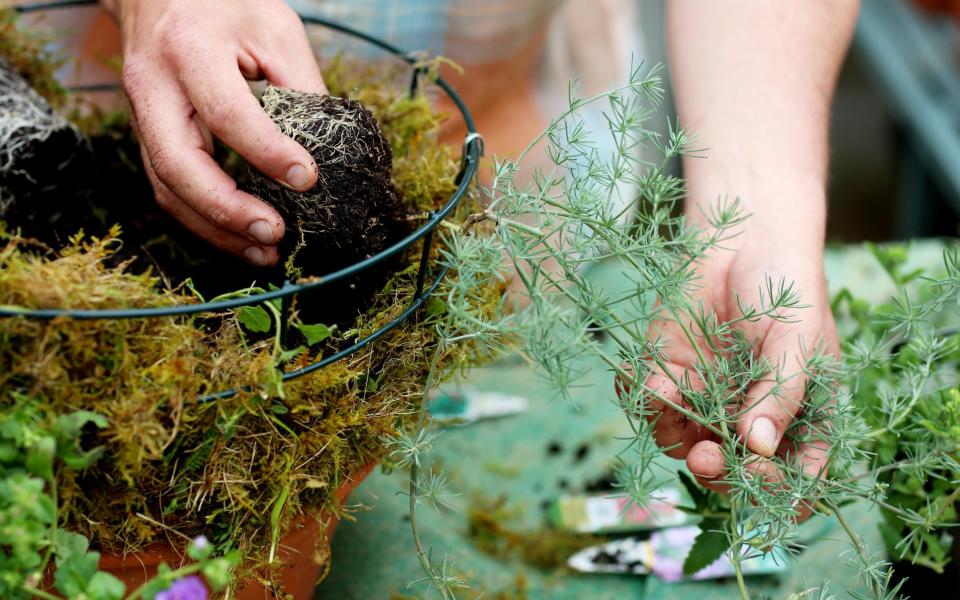How to plant a beautiful hanging basket

I’m very fortunate to have several fantastic nurseries in my area, and the other weekend I popped into one to buy some compost.
It seemed like the rest of West Sussex was there too; it was heaving with loads of people, frantically buying bedding plants of all shapes and sizes. This was a joyful sight, after the long, wet and grey spring that we’d experienced.
Seeing other gardeners filling their baskets and trolleys with plants highlighted that there is a huge amount of joy to be had in bedding plants.
With current gardening trends, have we drifted away from that joy – with bedding plants, seasonal containers and hanging baskets seemingly falling out of favour?
May is a great time to make the most of the wide variety of basket plants in small pots, as you can often save money because of the plant’s immaturity.
Creating your own now allows time for the basket or container to knit together, so that when you’re ready to dress the door, you’re weeks ahead of those who buy off-the-shelf products that can all look very similar to one another.
Hanging baskets provide a riot of colour at height, and a front door adorned with a colourful basket is a wonderful sight.
I’m a bit of a sucker for the traditional hanging basket full of pelargoniums, fuchsias, heliotropes and petunias, but you can let your imagination run wild and free with the kind of plants that you use.

Growing salad plants, strawberries, herbs, tomatoes or even succulents in a basket can all look wonderful and incredibly accessible at height.
If I’ve managed to whet your appetite to have a go yourself, then the bigger the basket that you choose, the better, because the larger volume of compost will retain more moisture and will dry out less frequently.
What you’ll need to create a beautiful hanging basket
A hanging basket
... made from wire, woven wicker or plastic. There are lots of different types of baskets available to buy, and you might have one or two kicking about at the back of your shed.
These are easy to resurrect as those old wire baskets go on forever and chains can simply be replaced to bring them back into commission. The benefit of using a wire basket is that you can insert trailing plants throughout, giving you a much fuller effect in comparison with a solid basket.
Liner or moss – with a circle of plastic from an old compost bag
Hanging baskets and liners are easy to pick up either in person at a nursery or online in a ready-to-go size that’s suitable for your basket, often with pre-cut holes. The source of sphagnum moss to use in hanging baskets is becoming a bit contentious and you need to make sure that you’re getting yours from a sustainable source.
I can’t confess to having a perfect lawn, and mine has quite a lot of moss, which on this occasion is incredibly useful, because I can scarify my lawn and collect the moss, using it as a liner – which not only is a more sustainable way of sourcing the moss, but also gives me a nudge to try to improve my turf. Take an old compost bag and cut a circle to cover the base of the basket to hold that little bit of moisture in a reservoir, which can be incredibly beneficial during the height of summer.
Peat-free compost
You can be forgiven for finding the world of composts quite confusing, as there are so many available. Any multipurpose, peat-free compost will be sufficient. The extra food that some compost has added to it can be quite fleeting and short-lived, so I would argue that it isn’t worth the extra money.
These plants are going to need our help throughout the summer, which involves daily watering and feeding at least once a week; that routine is going to make the difference between a great basket and a good one, rather than the compost you put the plants in initially.
Tomato and seaweed fertiliser
Keeping your plants buoyant and in great health will help to achieve a wonderful display. Once you’ve planted your basket, feed weekly with a liquid seaweed fertiliser to help those young plants establish and start to thicken up; the seaweed will promote size and foliage at this stage, rather than flowers. At the end of May, when the risk of frost is much reduced, your basket can go outside.
Continue to feed with the seaweed fertiliser until you are content that the plants have filled in, are of a reasonable size, and are now ready to start focusing on producing lots of flowers. At that point, switch your fertiliser to a tomato feed, which will promote more flowers, with less emphasis on bulk and foliar growth. Where our impatience can catch us out is when we try to promote flowers too early, without the plants achieving a reasonable framework to carry them.
How to plant a hanging basket
Step 1
Sit the basket in a terracotta pot and line the inside, either with a pre-made liner or a generous layer of moss. Add your reusable circle of plastic at the base of the basket, inside the liner.
Step 2
Create holes in the side of your liner (if not pre-cut) in the top two-thirds of the basket, as any lower holes may allow compost to escape when the roots haven’t yet filled the basket. For moss-lined baskets, line the bottom third of the basket.
Add compost up to the level of the cut holes in your liner or moss.
Step 3
Plant the root ball of your first trailing plant and gently thread the foliage through the basket, adding more moss or compost to cover the root ball.
Step 4
Repeat with more trailing plants around the sides.
Step 5
If using a liner, add more compost to within a few centimetres of the top of the liner. If using moss, continue to moss the rest of the basket to create your liner, before you add the remaining compost.
Step 6
Add plants to the centre of the basket to create a focal point, then add your cushion plants, and then trailers around the edge, and fill compost around them (see plant list for plant suggestions).
Step 7
Water well and feed with a seaweed fertiliser to settle compost around the plants with a rose attachment on your watering can.
How to maintain it
Aftercare
Keep the basket within the pot or hang in a greenhouse or porch and keep it frost-free until the end of May, allowing your basket to fill out before the big reveal to the neighbours.
Feeding
Encourage lots of strong healthy growth with no emphasis on flowers initially. As the structure of the plants begin to develop and a good framework is created, you can then start to switch to a high-potash feed that will encourage flowers.
Deadheading
The process of deadheading seems far too simple to make any great big impact, but trust me when I tell you that it does.
By deadheading a few times a week, the plants will continue to provide numerous flowers, supported by your watering and feeding regime.

Watering
Embrace a watering routine either first thing in the morning or in the evening, watering the basket with a rose on the end of a watering can or hose pipe so that the watering action is much gentler than a jet of water.
Take your time in watering your basket because you want the compost to become saturated throughout the rooting area. If you water too fast, that can cause runoff, which means that the water doesn’t go where you need it to be.

